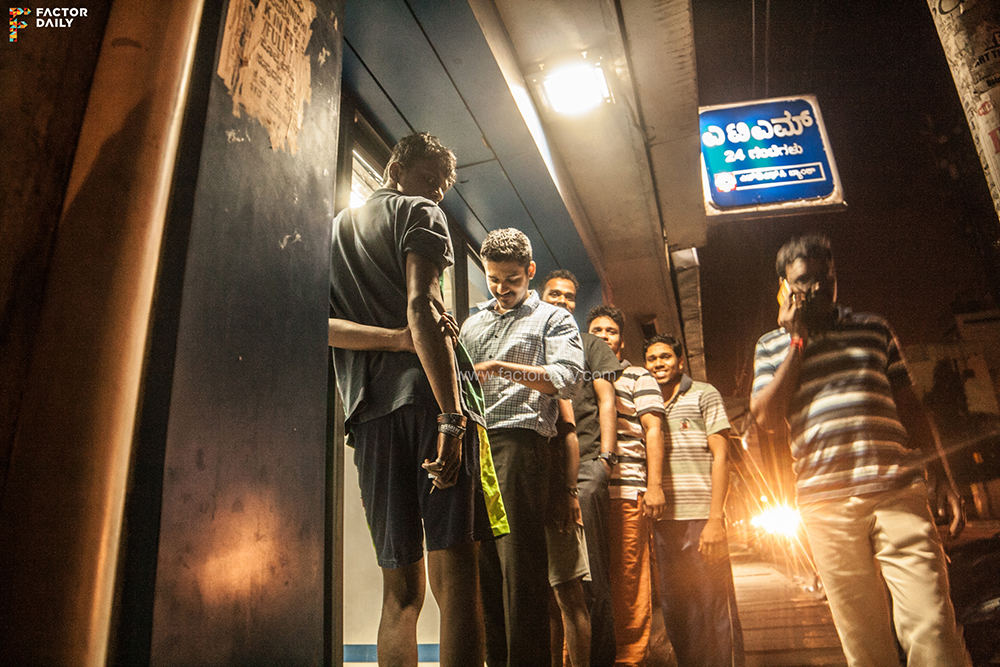My attempt to use a Rs 500 note at a medical shop yesterday (Thursday) was futile. After a mini argument, the guy behind the counter contended that only government medical shops were accepting the banned currency note. He wasn’t wrong. The Rs 500 note (as well as the Rs 1,000 note) isn’t legal tender anymore and retail outlets, including pharmacies, are not obliged to accept it.
My failure to use the demonetised paper money in a moment of need caused me some inconvenience. But, luckily, I am among those who have a bank account and debit and credit cards. So, I managed to buy the medicines I needed by crossing over to a medical shop that accepted plastic money.
But what if I didn’t have a card to pay with? What if I belonged to the other half of India’s population who are unbanked? I can’t even begin to imagine the chaos and the suffering the sudden move to demonetise the majority of the notes in circulation has created for this cash-reliant, unbanked, small-income segment of the country. A little over 80% of the total currency in circulation is high value notes. According to RBI’s annual report, at the end of March, there were 6.3 billion Rs 1,000 notes, and 15.7 billion Rs 500 notes in circulation.
It was a move so sudden that the average Indian was left gasping for breath. But, how impactful will the currency ban actually be in weeding out black money from the economy in the long term?
It was a move so sudden that the average Indian was left gasping for breath. However, the overwhelming narrative of “short-term pain, long-term gain” and the PR speak of “surgical strike on black money” seems to have taken some of the sting out of the burn the tough decision has caused the country. There is a rising sense of optimism as this is seen as the beginning of the end of black money in the Indian economy.
But, how impactful will this move actually be in weeding out black money from the system in the long term? Here are some thoughts on the ways in which the demonetisation will curb / stifle black money (and ways in which it won’t):
- It flushes out the cash-based black money from the system. The amount need not be insignificant as some are claiming. Those who actively use black money for their gains — politicians, mafia, terrorists (see a pattern here?) — and some industries with significant links to these (Bollywood, real estate, etc) are likely to be holding a significant amount of black money in liquid cash. This move will stifle deals and will impact key ‘projects’, including those seeking votes and alliances.
- It does nothing to the large cache of black money that people have stashed away abroad or even converted into white in the form of property assets and bullion. However, this one move is unlikely to address all problems at once. Besides, pursuing any black money that has been carefully legitimised is a fool’s errand. The intent here is to look forward from a clean slate.
- The new currency will do nothing different to curb black money at home either. With new Rs 500 and Rs 2,000 currency notes coming into circulation, the cycle of black money will start all over again. The incredible technology — nano-chips and GPS tracking — being claimed to exist in the new Rs 2,000 notes are just rumors so far. The RBI has claimed nothing yet and, besides, it looks like an unfeasible and expensive proposition to implement for the government. So, these currency notes will be no different from the notes that were removed from circulation except in security measures and design.

More Indians will actively seek out bank accounts and safety nets in the coming weeks and months, leading to greater financial inclusion - But, it’s not a futile exercise. The government has called a huge bluff and in one swoop invalidated all liquid black money in the country. What’s the guarantee that it won’t do it again? This fear will change habits. People will now want to convert any black money they stash into white as quickly as possible. And this is where the government can start squeezing more. With identification becoming mandatory for several large transactions, black money will get flagged more and tracked better. The government will squeeze the avenues to convert black into white.
- Financial inclusiveness will rise. The Jan Dhan bank account scheme gave bank accounts to millions of people who did not have one. With government interventions into regular transactions (like subsidies going into bank accounts) and such black swan events will propel millions of more Indians to seek bank accounts. As a result, financial inclusiveness will rise significantly. Besides, by now the government has sent a clear signal to everyone in the country — seek formal channels for transacting, storing and moving your money or face the music. More Indians will actively seek out bank accounts and safety nets in the coming weeks and months.
- However, a significant part of India’s population will suffer for days or even weeks due to their lack of liquidity.
Without a formal bank account and unsure about how to change their invalid notes, they’ll struggle to meet their daily needs and cope with emergency situations. But, to do this right means that the pain is unavoidable. In a way, this will help these very unbanked people in the long term as they will be compelled to seek out banks and get themselves included into the financial mainstream of the country. It’s like bitter medicine. - This could have been a spectacular moment in India’s history had the decision rollout been done with a massive deployment of support systems. Ideally, the government should have mobilised vast amount of human resources to guide, educate and help the people — from banks to financial institutions to field agents — make this transition. It would have been the greatest movement towards economic formalisation that has ever happened in a short time. But, the necessary secrecy surrounding the move meant that this large mobilisation could not have happened prior to the announcement. But, it could still happen. If the government could rapidly set up support centres and agents to help people wade through this period and perhaps even get bank accounts, it would be a win-win for everyone.

Most of India’s population still works in the informal sector. They don’t have bank accounts and are unsure about how to change their invalid notes. They will struggle to meet their daily needs and cope with emergency situations - An outcome of the previous steps would be the greater formalisation of our economy. Even today, most Indians work in the informal economy. With greater financial inclusiveness, and also the growing cost of illegal transactions, our economy would get more formalised (tracked and regulated). The labour market will benefit eventually. Moneylending, which was fuelled significantly by black money, will take a more formal, regulated form. Formalisation of the economy means more tax, greater data and better schemes and policies that take the welfare of workers into account. With the tax base growing, the government could even envisage bringing down tax rates at some point.
- Also, digital transactions will see a spike and greater adoption eventually. The government has signalled that cash could be an uncertain way to deal with in transactions and, therefore, using digital equivalents is a safety net people should adopt. My dad, at 67, has decided since Tuesday night that he needs to get a debit card for himself after having been a cash-only man all his life. There are millions like him. This panic may be a good thing in the long run. This will pervade all forms of digital payments, from Unified Payments Interface (UPI) to wallets to credit and debit cards.
- Eventually, all this means that the noose around unaccounted black money has tightened and it will become a lot more difficult (but not impossible) for people to continue the same kind of transactions in the days / years to come. Black money exists because of the arbitrage against the cost of government tax and because of weak processes. The arbitrage will continue to exist and people will support it because it means lower prices. With the Rs 2,000 notes, it may even be easier to store and move black money. Also, nudged by this move, black money hoarders will get more robust in how they store it in future — gold, forex and bitcoins. So, it is not unfeasible that in the next five years, we will be seeing a bulge of black money in our economy again. The hope is that it is likely to be a smaller percentage of the overall economy due to all the reasons mentioned above. But, can the government remain on top of all the ways technology can enable the conversion of black money going forward?
- There’s politics here that is undeniable. It gives Modi that big move to prove one of his biggest campaign promises — fighting corruption and eradicating black money. While I believe the long-term impact of other subtler policies and schemes (like Jan Dhan or Aadhar-based subsidies, etc) will be much greater, the optics of this is way more powerful than anything else. It has given India one mega event that it can recall as the day Modi declared a war on black money. This is fine. This is politics. Also, the UP elections are coming.
Subscribe to FactorDaily
Our daily brief keeps thousands of readers ahead of the curve. More signals, less noise.
To get more stories like this on email, click here and subscribe to our daily brief.
Photos: Rajesh Subramanian and Ramarko Sengupta








